Nissan offers reason to turn over a new Leaf
By John Gilbert
If you’ve never heard about Guy Clark’s fabulous song-writing, find a way to get your hands on his “Best of the Dualtone Years” album and anticipate about six months of fantastic entertainment. In his classic “Texas, 1947,” he wrote about the people coming down to the depot to see the first diesel train speed past, and he says the folks were “…wondering what it’s coming to, and how it got this far.”
If it was written more recently, Clark might have been inspired by driving the new Nissan Leaf, an all-electric vehicle that can truly push any observer to such puzzlement.
There have been many stories about the development of electric cars, such as the privately owned Tesla vehicles, and virtually every manufacturer either has experimental models on the streets, or is nearing production status.
Nissan, meanwhile, simply acts where rivals promote, and it brought out the Leaf almost a decade ago and started selling them, mostly on the West Coast, but also in the East and in Florida. Now they sell them all over the U.S. Looking a lot like a subcompact Versa, sort of boxy and unexciting, the Leaf was swift and performed well, and it stands as the No. 1 electric car sold worldwide, a status it has attained quietly — literally and figuratively.
For 2018, Nissan has redesigned the Leaf, making it look very Nissan like from the signature nose, and positively futuristic from the rear and side. Suddenly the Leaf has enough appeal to lure mainstream customers, not just those who are insisting on not paying the wildly fluctuating $3-plus per gallon of gasoline. If they go to a Nissan dealer and test-drive one, they will be more impressed.
You can buy a Leaf SL for a base price of $36,200, or a loaded, as-tested SL for $38,510. That, however, is before you figure out the tax-break deductions a zero-pollution vehicle can get. Best estimates are that a loaded Leaf might be obtainable for around $27,000. That’s about half what a Tesla Model 3 goes for, and close to half of a new Chevrolet Bolt EV.
I was eager when I learned I would get a 2018 Leaf for a week-long test drive. I was less impressed when the delivery service showed up with the Leaf riding comfortably on the back end of a flat-bed hauler. I had been hoping it would be driven here, because even though it started out in Chicago and would have stopped for a few recharging sessions, it would have meant the Leaf’s range was sufficient to consider it an everyday driving candidate.
The plan is that the 2019 Leaf will g a larger and more powerful battery-pack, which could boost between-charges driving range to up near 300 miles.
As it is, the 2018 test model showed a range of 150 miles between charging sessions, which is certainly more than adequate for driving to and from work and tossing in a venture out for dinner and maybe a movie or the shopping center, knowing you can plug it in overnight and be ready to go in the morning.
My wife, Joan, and I decided to make it an adventure, planning to drive from Duluth, Minn., to the tiny Wisconsin vacation town of Lake Nebagamon, nearly 50 miles from our home. Joan had spent part of every childhood summer at her grandma’s home there, and she vividly recalls the fun of spending whole days at the public beach, with highlights of her first-ever experiences with a new Minnesota delicacy — Dairy Queen — which was, and still is, about 100 yards up the boat-launching slope from the water.
I’m not sure how many Nissan Leafs (Leaves?) have ever appeared in Lake Nebagamon, but a measure of how far it has gone was that numerous passers-by glanced at it, or even looked hard at it, but didn’t seem to think it was anything unusual.
For those people, it’s always most fun to hop in the Leaf, hit the starter button, and hear the engine roar to life. Just kidding! There is no noise — zero. You simply shift into gear and take off swiftly while those passers-by gaze after you with some degree of marvel. Even if they never heard of the late Guy Clark, and his fantastic Texas folk-country song-writing.
Nissan is a Japanese giant that tends to forge ahead, rather than spend time promoting its newest stuff, and the Leaf is a perfect example. Back in 2010, Nissan invited auto media to Tennessee to first drives of the new Leaf, and I’ll never forget the instant acceleration and completely silent operation, which was the stuff of Star Wars. Then I swapped seats with my conservative-seeming co-driver and observed him hammer the “gas” pedal. We went faster and faster, very quickly, still not making a discernible noise. I glanced over at the instruments and noticed we were sailing along at 103 miles per hour. We had been told the Leaf might go 90 or so, but unless the speedometer was wacko, our test vehicle easily surpassed that. It reached showrooms as a 2011 model.
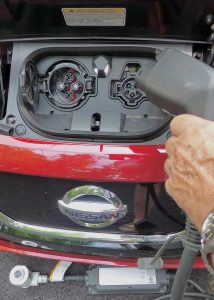
Convenient plug location for normal or quick charging replenishes gasoline-free range of over 150 miles.
The only question then, as now, is the range you can go before you run out of electric power and need to plug in. Over the years, battery-makers have gotten better and better, with each plateau of sophistication meaning quicker recharge, greater capacity, and longer range. Companies like Panasonic, Sanyo, Samsung and various others, up to and including LG from South Korea, have reached amazing levels.
That wasn’t good enough for Nissan, which went ahead and built its own facilities for building the necessary batteries to make hybrids, and pure-electric cars, function. The Leaf is built in Smyrna, Tennessee, and the battery pack is built in Smyrna, Tennessee.
The current 2018 Leaf SL test vehicle has a 40 kilowatt-hour Lithium-ion battery that operates a 110 kilowatt-hour synchronous motor. It also has 6.6 kilowatt onboard charger, and a quick-charge port. My mind boggles at the idea of trying to equate kilowatts to horsepower, whether battery or motor. (Did you know that you can call an electric motor a “motor,” while a gasoline engine is an “engine?”)
So to unboggle my mind, my best measurement of an electric car is to get in, hit the starter button, engage the “D” tab on the shifter and hit the go pedal. Then try to calculate how swiftly the fence posts or trees whiz past.
We’re used to gasoline engines, which roar louder and louder as the RPMs build, leading to the horsepower peak at somewhere up around 5,000 revs. Electric motors, on the other hand, have maximum torque at zero RPMs. So when you take off, you really take off.
Best estimates show the Leaf going 0-60 in about 7.5 seconds. I didn’t check. All I knew was it was fast enough, and because there is only silence, you need to pay attention to your speedometer.
Other settings on the instruments can be switched to give you remaining range and percentage of remaining electricity stored in the Leaf battery pack.
We plugged the adaptor cable into the nose receptacle, and the other end into a three-pronged 220 plug in our garage. That’s the middle of three methods of recharging. Level 1 is into normal household 110-120, which takes about 10 hours for a full charge, and Level 2 is to plug into a 220 outlet, which can recharge full in 4 hours. Level 3 is a high-end charging station, of which there might be a lot in California, and get about 85 percent recharge in about 20 minutes.
In Duluth, Minnesota, with its legendary winter cold, there are a grouping of EV charge stations about a block south of Superior Street, and at the north tip of the main Canal Park motel, restaurant and entertainment area. You plug in, swipe a credit card, and return from a nearby movie or dinner to a fully charged car.
We plugged in at home, overnight, and found the instruments told us we had 93 percent maximum charge, worth a range of 158 miles. The max is supposed to be 150 miles, but like hybrids, electric vehicles learn your driving style and adapt immediately. If you drive economically, your range will increase. If you drag race your neighbors on the way to work, it will go down.
Same with severe cold. I know from past experience the best batteries in cameras, tape recorders, audio players and electric-aided cars plunge quickly when exposed to extreme cold. I’m not sure about the newest Leaf, but extending the range is the primary concern. We know we can park it in a garage overnight, dash to work, and no matter how cold still have enough juice to get home.
As for our trip to Lake Nebagamon, we zipped over the big bridge into Wisconsin, then followed our GPS down the little roadways to the town. We drove around for a while, making sure to locate the house once owned by Joan’s grandmother, toured town briefly, but totally, then parked down by the beach.
We also walked around a bit to check out assorted locations, then had a ceremonial Dilly Bar at the Dairy Queen before heading back toward Duluth.
During the rest of the week, we drove up hills and down, and checked out the fantastic “e-pedal” switch, which assures you of instant deceleration whenever you lift off the accelerator. It reverses the motor, capturing regenerative electric power to ostensibly increase your range. But in Duluth, where you face a lot of steep hills, you went up swiftly, and could go down efficiently by lifting your toe and letting the car slow itself.
It works so well that if you are approaching a car ahead stopped at a light, you can let off and it will slow you down completely to a stop. Outstanding.
Interior appointments aren’t fancy, but they’re effective. Leather seating, complete and simple instrumentation and a potent audio system are all standard features, as is the normal high-tech driving aids such as vehicle dynamic control, blind-sport warning, rear cross-traffic alert, and more common stuff such as traction control, antilock brakes and electronic brake assist and distribution.
I was startled by one feature. The automatic braking and accident-avoidance feature is, in a word, sensitive. Joan and I went to a movie with an adjacent parking lot, and because of construction you can only leave by driving through the bottom level of a ramp and proceed through an automatic rising horizontal arm. I advanced slowly, and when I was first in line, I drove ahead slowly, timing the arm as it rose.
Suddenly — very suddenly — the car emitted a nasty growl and stopped on a dime. I was sure something had broken or malfunctioned. Then I realized it was the avoidance system, which caught the radar bounce of the rising arm and inspired the Leaf to stop instantly.
We’re all going to be driving hybrids or electric vehicles of some sort someday, or sooner. When you realize the price sticker shows the fuel-economy equivalent of 112 mpg city and 100 highway, you also realize that if you drove the Leaf for 10 years, to work and back every day, and on trips whenever you felt comfortable with the range, you would spend a grand total of $0 for gasoline.
Think about it, while you’re listening to Guy Clark wondering where it’s coming to and how we got this far. We’re going to be coming farther, and soon.


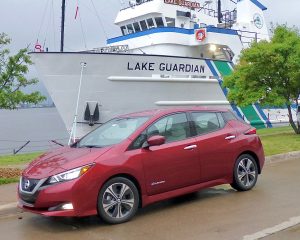
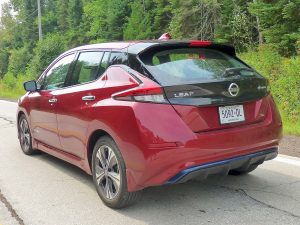
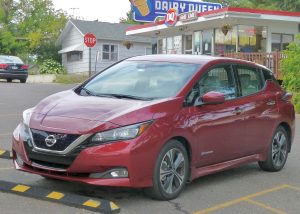
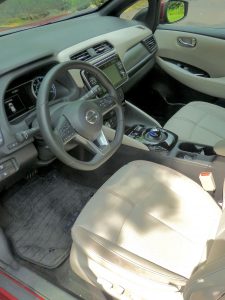
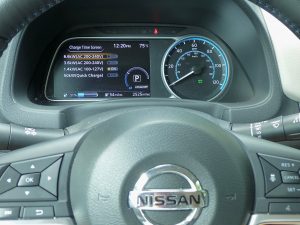
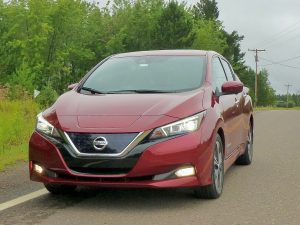
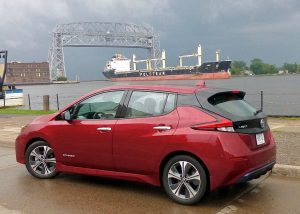
 John Gilbert is a lifetime Minnesotan and career journalist, specializing in cars and sports during and since spending 30 years at the Minneapolis Tribune, now the Star Tribune. More recently, he has continued translating the high-tech world of autos and sharing his passionate insights as a freelance writer/photographer/broadcaster. A member of the prestigious North American Car and Truck of the Year jury since 1993. John can be heard Monday-Friday from 9-11am on 610 KDAL(www.kdal610.com) on the "John Gilbert Show," and writes a column in the Duluth Reader.
John Gilbert is a lifetime Minnesotan and career journalist, specializing in cars and sports during and since spending 30 years at the Minneapolis Tribune, now the Star Tribune. More recently, he has continued translating the high-tech world of autos and sharing his passionate insights as a freelance writer/photographer/broadcaster. A member of the prestigious North American Car and Truck of the Year jury since 1993. John can be heard Monday-Friday from 9-11am on 610 KDAL(www.kdal610.com) on the "John Gilbert Show," and writes a column in the Duluth Reader.